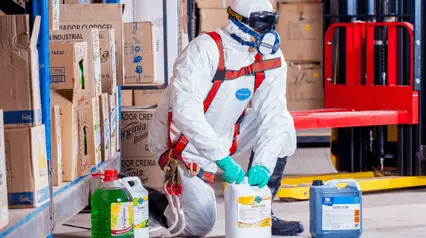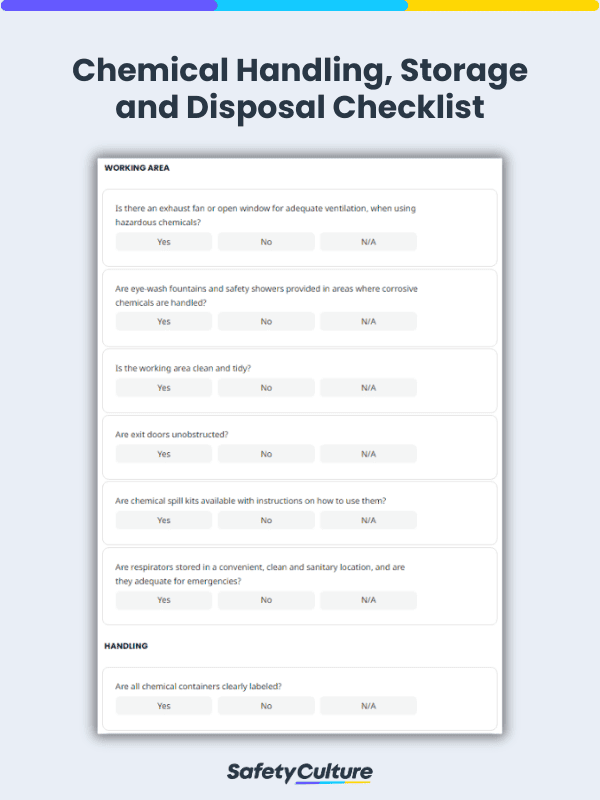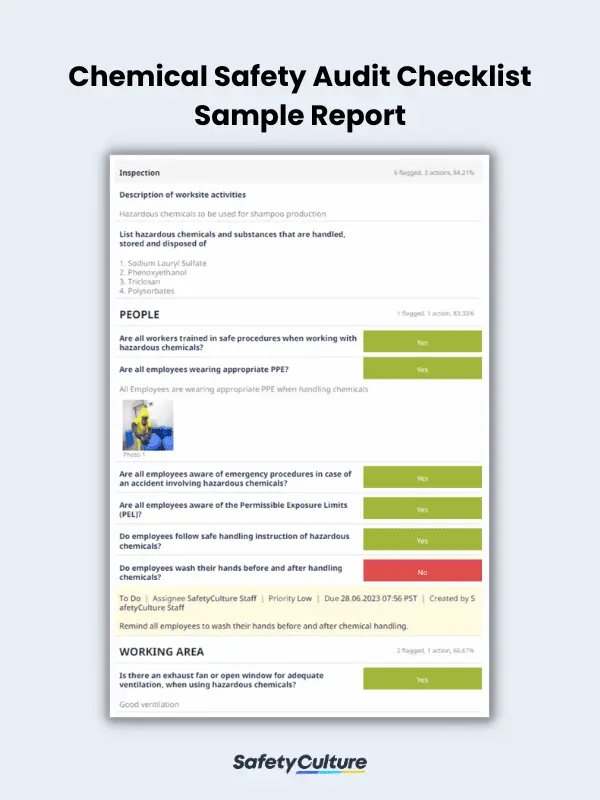What is a Chemical Safety Audit Checklist?
A chemical safety audit checklist is a tool used to evaluate systems in place that manage the safety of chemical handling, storage, and usage within a workplace or facility. Performing chemical safety audits with the help of this checklist ensures that the systems in place follow best practices and are adequate and effective. This tool can also be used to ensure compliance with local regulations in the proper handling of hazardous chemicals.
Importance of Auditing the Safety of Chemicals Management
Proper handling, storage, and disposal of hazardous chemicals in the workplace can help reduce exposure to toxic materials and related workplace incidents. Without proper controls and training in place, exposure to chemicals can cause burns, respiratory illnesses, and cancer, as well as fire and explosion-related injuries. Hence, any industry that handles hazardous chemicals needs to be aware of safety practices and common harmful chemicals, including (but not limited to) paints, disinfectants, glues, heavy metals, pesticides, and petroleum products.
With these in mind, regular chemical safety audits aided by standardized checklists can help identify gaps in dealing with hazardous chemicals and prevent incidents before they occur.
Why Use a Checklist for Chemical Safety Audits
When conducting chemical safety audits, using a checklist offers key benefits that enhance the efficiency and effectiveness of the audit process. Here are some compelling reasons why you must incorporate the use of checklists in your workplace operations:
Systematic Evaluation
By providing a structured framework, checklists ensure that no critical aspects of chemical safety are overlooked. Auditors can systematically assess each element of safety protocols and procedures, reducing the likelihood of missing important details.
Consistency and Standardization
Chemical safety audit checklists also establish a consistent and standardized approach to safety audits. Regardless of who is conducting the audit, similar elements or areas are evaluated, making it easier to compare findings over time and across different facilities.
Documentation and Accountability
Checklists serve as a record of the audit process, documenting what was reviewed, any issues or areas of improvement, and the recommended corrective actions. This documentation is essential for accountability, compliance, and tracking progress in implementing safety measures.
What to Include in a Chemical Safety Audit Checklist
Depending on the needs of your organization, you must create and use a chemical safety audit checklist that’s suitable for your needs. While you can customize this template, make sure to include the following elements and sections to make it comprehensive:
- Title Page – client name/site name, date and time of the audit, name of auditor, location, description of worksite activities, and list of hazardous chemicals and substances that are handled, stored and disposed of
- People Information – questionnaire on personnel training, awareness of emergency procedures, and proper wearing of Personal Protective Equipment (PPE)
- Working Area Audit – questionnaire on the maintenance of working areas for hygiene and safety
- Handling, Storage, and Disposal Process Inspection – questionnaire on whether chemical containers are labeled, in a good and safe condition, and chemical waste is in a suitable location
- Completion Page – observations, comments, recommendations, and sign-off
How to Conduct Chemical Safety Audits Using a Checklist
Using audit checklists involves a series of steps to help you assess and improve chemical safety practices in your organization. Follow this guide to ensure a comprehensive and effective chemical safety audit:
1. Pre-Audit Preparation
Before initiating the audit, gather all relevant documents, including Safety Data Sheets (SDS), chemical inventories, and existing safety protocols. Ensure that the audit team is properly trained and informed about the audit’s scope and objectives.
2. Checklist Customization
Tailor the chemical safety audit checklist to the specific needs and risks of your workplace. Modify checklist items to match the types of chemicals, processes, and safety regulations applicable to your facility.
3. Site Visit and Inspection
Conduct a physical inspection of the workplace, examining chemical storage areas, handling procedures, emergency equipment, and personnel adherence to safety protocols. Use the checklist as a guide to ensure thorough coverage of all safety aspects.
4. Documentation and Observation
As you go through the checklist, document your observations and note areas of compliance and non-compliance. Taking photographs or videos may also provide visual evidence of conditions.
On the other hand, make sure to engage with employees involved in chemical handling and safety practices. Their insights can provide valuable information on the practical implementation of safety procedures.
5. Recommendations and Corrective Actions
Create a list of recommendations for improving safety practices and outline specific corrective actions. Don’t forget to assign responsibilities and set timelines for implementing these actions.
6. Reporting and Follow-Up
Prepare a comprehensive audit report that includes all findings, recommendations, and corrective action plans. Share this report with relevant stakeholders and follow up to ensure that corrective actions are completed.
7. Continuous Improvement
Chemical safety audits should be viewed as an ongoing process to be regularly conducted. Use the findings from one audit to inform and improve safety practices, and schedule future audits to monitor progress and address emerging concerns.
You can use the following sample report for a conducted chemical safety audit using SafetyCulture (formerly iAuditor):
FAQs About Chemical Safety Audit Checklists
The frequency of using chemical safety audit checklists can vary based on various factors, including the nature of the workplace, the types of chemicals used, and regulatory requirements. However, it’s common for organizations to conduct in-depth chemical safety audits annually.
Some companies can also opt to perform routine or periodic audits quarterly, bi-annually, or any other frequency determined by the nature of the chemicals they’re handling.
The key purpose of these checklists is to assess and improve safety practices and compliance. However, they can also be leveraged as a tool to support the search for safer alternatives for hazardous substances. That way, the use of chemical safety audit checklists can go beyond checking safety processes in place.
Yes, there are software and digital tools designed to streamline the chemical safety audit process, improve efficiency, and enhance recordkeeping. Some of these tools’ most common features are the following:
- Checklist Creation
- Digital Data Collection and Analysis
- Photo and Document Attachment
- Automated Reporting
- Access to Historical Data
- Offline and Mobile Accessibility




